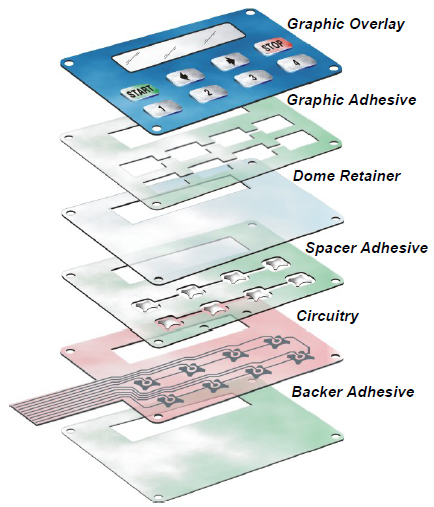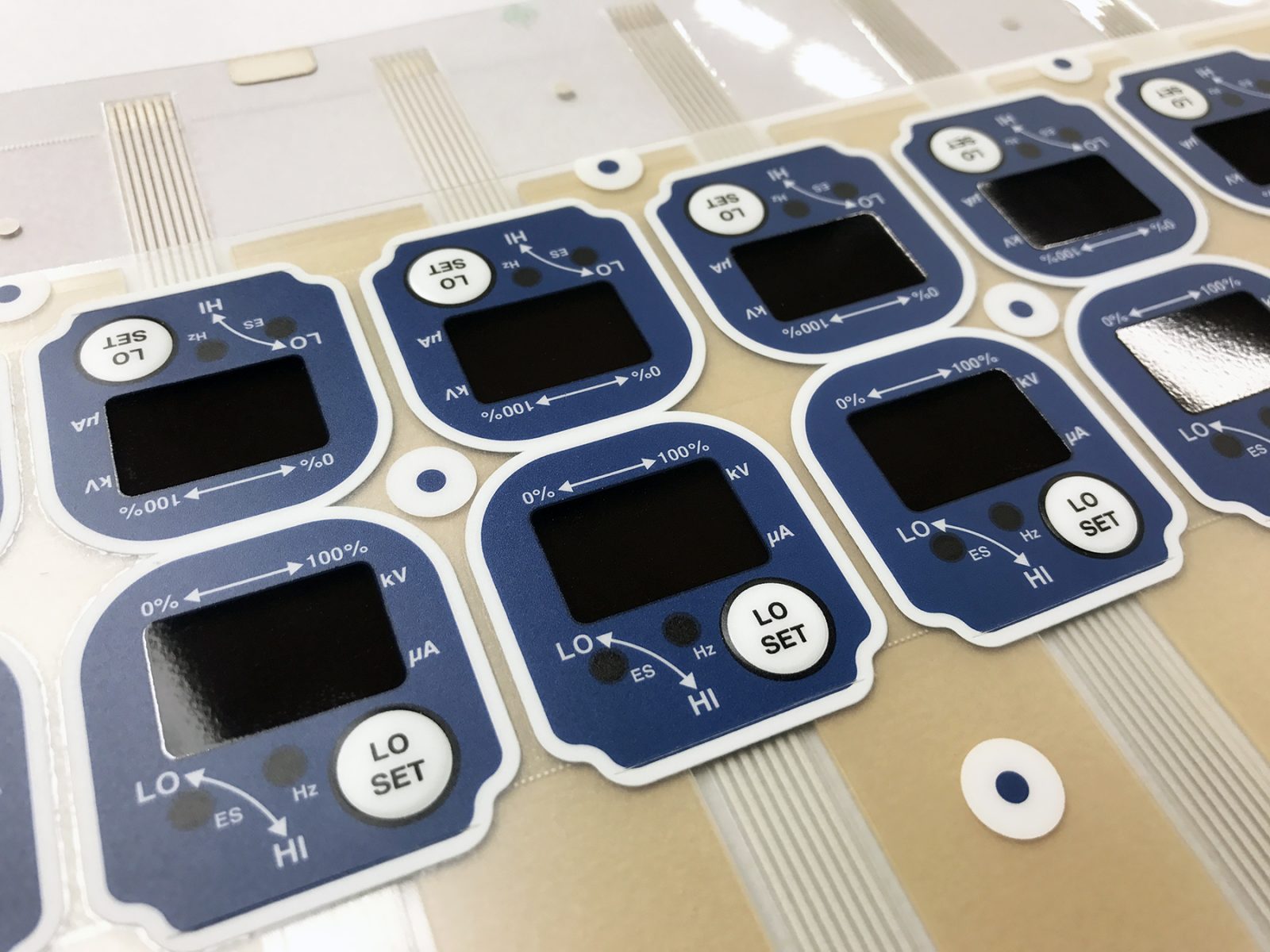What to Look for When Selecting a Membrane Layer Switch for Your Task
When you're picking a membrane button for your project, numerous essential factors enter play. You'll require to consider the materials, design, and exactly how well it aligns with your brand name. Sturdiness and use are essential, however so is the credibility of the producer. Comprehending these components can help you make an educated choice-- one that stabilizes quality and price successfully. Let's discover what you ought to take into consideration to ensure your selection satisfies all your project needs.
Comprehending Membrane Switch Over Components
When you plunge right into the world of membrane layer switches, it's vital to realize the essential elements that make them function. The switch commonly contains 3 primary layers: the visuals overlay, the spacer layer, and the circuit layer. The visuals overlay offers the visual user interface, showing buttons and signs you require for very easy navigation. Beneath that, the spacer layer warranties there suffices range in between the circuit and the overlay, allowing the switch to activate without consistent stress.
Recognizing how these layers work together aids you choose a membrane button that's reputable and fits your task demands. Pay close focus to the density and product of each layer, as these elements influence sturdiness and performance in different atmospheres.
Product Choice and Its Effect
Choosing the ideal products for your membrane layer switch can substantially influence its efficiency and long life. The option of substrate, normally polyester or polycarbonate, influences resilience and versatility. Polyester is more abrasion-resistant, while polycarbonate offers better quality and stamina.
Following, think about the adhesive. It needs to endure environmental aspects like dampness and temperature adjustments. A solid sticky guarantees that your membrane layer button stays undamaged over time.
Do not fail to remember regarding the visuals overlay. The printing approach utilized, whether silkscreen or digital, impacts the button's appearances and durability. Top quality inks will stand up to fading and scraping, keeping a specialist appearance.
Lastly, think of environmental conditions. If your gadget will be subjected to severe chemicals or severe temperature levels, pick materials developed to endure these challenges. Your selections in products will eventually establish the button's reliability and customer fulfillment.
Layout Considerations for User Experience
Choosing the best materials lays the foundation for a successful membrane layer switch, but the design additionally plays a significant duty in individual experience. You'll wish to mirror on exactly how the format affects use (membrane switch manufacturer). Maintain switches and symbols intuitive and well-spaced, making it simple for customers to navigate without confusion

Shade and comparison are also necessary; guarantee that your layout is visually attractive yet still useful. High contrast assists individuals quickly determine switches, particularly in low-light problems.
Last but not least, mirror on the general aesthetic. A smooth and modern-day layout can boost individual understanding and make your item much more enticing. Balancing performance with an appealing layout will cause a better individual experience and ultimately, an extra effective product.

Ecological Factors and Resilience
When choosing a membrane layer switch, you need to think about exactly how it'll perform in various environments. Aspects like temperature resistance, dampness and chemical direct exposure, and mechanical wear can substantially influence its durability. Understanding these components will certainly assist you select a switch that stands up to your details problems.
Temperature Resistance Requirements
As environmental problems can vary extensively, understanding temperature resistance is essential for guaranteeing the resilience of your membrane switch. You require to assess the temperature range in which your tool will operate. High temperature levels can create products to weaken, leading to failing, while low temperature levels might make parts fragile and vulnerable to splitting. See to it to check the requirements of the materials made use of in the button, like the glue and overlay, as they directly effect efficiency. It's also a good idea to consider possible temperature fluctuations and their effects on the switch's integrity. By selecting a membrane layer switch with ample temperature resistance, you'll boost its lifespan and preserve performance in challenging settings. Pick intelligently to stay clear of costly substitutes down the line.

Wetness and Chemical Exposure
Wetness and chemical direct exposure can significantly influence the efficiency and longevity of your membrane button, so it's vital to recognize the environment in which it will be used. If your job includes high moisture or direct exposure to liquids, search for protective coverings and sealers that can boost resistance to dampness. Furthermore, take into consideration the sorts of chemicals your button might run into. Specific products can break down when revealed to solvents, oils, or these details extreme cleaners. Picking the best materials, like polycarbonate or polyester, can help resist these elements. Always speak with the producer's specs for chemical compatibility to guarantee your membrane button keeps its capability over time. By prioritizing moisture and chemical resistance, you can boost the durability of your switch in tough environments.
Mechanical Deterioration
While you might focus on features like aesthetic appeals and functionality in your membrane layer button, mechanical wear and tear can greatly influence its performance over time. Regular pressing can lead to deterioration of materials, creating concerns like responsive comments loss or even change failure. Picking a resilient switch assurances durability and dependability, avoiding pricey substitutes and downtime in your task.
Customization Options for Branding
When it pertains to branding your membrane layer switch, personalization choices are essential. You can select design elements and colors that mirror your brand, along with specific logo positioning and dimension to improve exposure. Furthermore, choosing the best materials and structures can elevate the general feel and look, making your item stick out.
Style Elements and Colors
A variety of style aspects and colors can make your membrane button not just functional but also aesthetically enticing, improving your brand name identification. When choosing shades, assume regarding your brand name's palette; they should reverberate with your audience and stimulate the ideal emotions. You can additionally explore numerous finishes like matte or shiny to develop various visual effects. Do not fail to remember about structures; adding a responsive element can enhance user experience and make your switch stand apart. Consider including customized graphics or patterns that align with your brand message. By attentively choosing style elements and shades, you not just produce an item that looks excellent but also strengthens your branding consistently and efficiently.
Logo Placement and Size
After settling your layout aspects and shades, the following action is to focus on logo design positioning and size. Your logo is a crucial facet of your branding, so you'll desire it to stand out without overwhelming various other style aspects. Show on where your logo will be most visible and impactful; common positionings include the leading or center of the button.
Assume concerning the size also-- as well big and it may outweigh useful components, also tiny and it might get lost. Go for a balance that allows your logo design to be easily recognizable while maintaining the total appearances. Do not neglect to ponder how the logo design straightens with individual interaction. This focus to detail will enhance both functionality and brand name identification in your job.
Product and Structure Choices
Selecting the appropriate materials and textures for your membrane layer button can substantially improve both its capability and aesthetic appeal. You'll intend to evaluate choices like polyester or polycarbonate, as they this link provide resilience and resistance to wear. The texture of the surface area likewise plays a necessary role; smooth coatings supply a sleek appearance, while distinctive surfaces can enhance grip and responsive feedback.
Personalizing the materials and structures allows you to show your brand name identity effectively. For example, you might choose a matte finish to convey refinement or a glossy try to find a modern-day touch - membrane switch manufacturer. Don't ignore color choices, as vivid hues can make your button stick out, while soft tones can develop a more stylish look
Price vs. High Quality: Locating the Right Equilibrium
When you're managing the alternatives for membrane buttons, stabilizing expense and quality can feel frustrating. A lower-cost button could conserve you cash upfront, however if it endangers capability, you could encounter higher substitute expenses later.
Search for producers that provide a great mix of cost and high standards. Research study their track record and client evaluations to evaluate reliability. Often, spending a bit more in top quality materials can conserve you from future migraines.
Likewise, consider the long-lasting performance and guarantee options. A a little extra pricey button with a solid service warranty can confirm to be a smarter financial investment. Ultimately, it has to do with discovering that sweet place where you meet your spending plan while ensuring your project's success.
Examining and High Quality Assurance Protocols
While you could discover the excellent membrane layer switch layout, assuring its quality via extensive testing procedures is vital for long-term success. Begin by verifying that the supplier complies with sector requirements, such as IPC/WHMA-A -620, to assure a reputable item. membrane switch manufacturer. You'll desire to check for thorough testing techniques, consisting of environmental, mechanical, and electrical analyses
Make specific the buttons undertake durability testing, mimicing real-world usage to identify any prospective failings. Focus on the manufacturer's quality assurance process, which must consist of regular examinations and audits.

Don't fail to remember to request for examples and conduct your own examinations to validate compatibility with your task. Finally, think about how frequently the producer updates their procedures; advancement in screening can result in improved quality. By prioritizing these testing and quality control methods, you'll raise the likelihood of an effective and sturdy membrane layer button for your application.
Often Asked Concerns
The length of time Does a Membrane Switch Typically Last?
A membrane layer button commonly lasts anywhere from 1 to 10 million cycles, depending on use and ecological elements. You'll wish to think about your particular demands to assure it satisfies your longevity needs successfully.
Can Membrane Switches Be Repaired if Damaged?
Yes, you can often fix membrane layer switches if they're harmed, however it frequently depends on the degree of the damage. Minor problems could be reparable, while extra significant damages typically requires substitute for proper performance.
What Are the Common Applications for Membrane Layer Switches?
Membrane layer buttons are commonly used in home appliances, medical gadgets, and auto controls. You'll discover them in customer electronics, commercial devices, and even video gaming consoles. Their versatility makes them excellent for different individual interfaces and settings.
Are There Certain Certifications for Membrane Layer Buttons?
Yes, there specify certifications for membrane layer buttons. Try to find UL, CE, and RoHS certifications to guarantee safety and conformity. These certifications suggest the button fulfills sector standards for top quality and this article environmental safety.
Just how Do I Ensure Appropriate Installment of a Membrane Change?
To assure proper setup of a membrane layer switch, tidy the surface area thoroughly, align it thoroughly, and use even pressure. Adhere to maker standards for sticky curing time to maximize longevity and performance.
Conclusion
When choosing a membrane button for your task, keep these essential variables in mind: focus on resilient materials, emphasis on straightforward style, and consider customization for your brand. By meticulously examining these facets, you'll ensure your membrane button not only fulfills your job needs however likewise enhances individual experience and reflects your brand identification effectively.